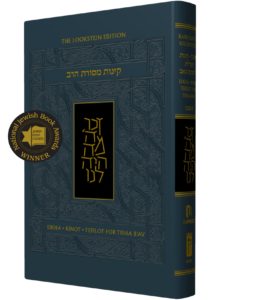Excerpted from the Koren Mesorat HaRav Kinot: Lookstein Edition. Edited by Rabbi Simon Posner, Kinot translated by Rabbi Dr. Tzvi Hersh Weinreb.
 Kina 10, Eikha Yashva Havatzelet HaSharon
Kina 10, Eikha Yashva Havatzelet HaSharon
Why is it that the stringency of our observance of mourning decreases in the afternoon of Tisha B’Av, at precisely the time that the flames of destruction began to engulf the Beit HaMikdash?
כי כליה חיבתי כדור המבול For we deserved extinction no less than the generation of the Flood. This passage sounds the recurring theme found in the kinot that the Beit HaMikdash served as a substitute, as collateral, for the Jewish people, and the physical structure of the Beit HaMikdash suffered the destruction that rightfully should have been visited upon the entire nation. The kina says that the Jewish people are responsible and are deserving of punishment; we are guilty, and we should have been destroyed as was the generation of the Flood. God, however, in His mercy and grace, subjected His throne, the Beit HaMikdash, rather than the Jewish people, to disgrace, abuse and destruction. It is for this reason that Tisha B’Av contains an element of mo’ed, a festival – God rendered His decision on Tisha B’Av that Knesset Yisrael is an eternal people and will continue to exist. The Beit HaMikdash was humiliated, profaned and destroyed in order to save the people.
This concept is expressed halakhically in the character of Tisha B’Av afternoon. The second half of the day has a contradictory nature in halakha. On the one hand, the avelut, the mourning, is intensified because the actual burning of the Beit HaMikdash commenced in the late afternoon of the ninth day of Av, and the flames continued throughout the tenth (Ta’anit 29a). On the other hand, Nahem, the prayer of consolation, is recited in the Amida for Minha in the afternoon, and not in Shaharit of Tisha B’Av morning or Ma’ariv of the preceding evening (Shulhan Arukh, Orah Hayyim, Rama 557:1). Similarly, tefillin are put on in the afternoon, not the morning (Shulhan Arukh, Orah Hayyim 555:1), and sitting on chairs rather than on the ground is permitted in the afternoon, not the morning (Shulhan Arukh, Orah Hayyim 559:3).
In Minha, one re-inserts in Kaddish the phrase תתקבל צלותהון ובעותהון”, accept our prayers and entreaties” (see Beit Yosef, Tur Orah Hayyim 559 s.v. ve’omer kaddish belo titkabal, with respect to the recitation of Titkabal in Shaharit). This phrase is removed from Kaddish earlier on Tisha B’Av because the assertion that “satam tefillati, my prayer is rejected” (Lamentations 3:8), which prevails on Tisha B’Av, comes to an end at midday. Paradoxically, the moment the Beit HaMikdash was set ablaze was a moment of relief. At that moment, it became clear that God decided to take the collateral, the Beit HaMikdash, instead of pursuing the real debtor, the Jewish people. Paradoxically, once He took away the Beit HaMikdash in the afternoon of Tisha B’Av, the nehama, the consolation, could begin. Tisha B’Av is a day of limitless despair and boundless hope and faith.

